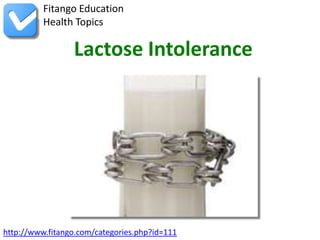
Lactose Intolerance
- 1. Fitango Education Health Topics Lactose Intolerance http://www.fitango.com/categories.php?id=111
- 2. Overview Lactose intolerance is the inability or insufficient ability to digest lactose, a sugar found in milk and milk products. Lactose intolerance is caused by a deficiency of the enzyme lactase, which is produced by the cells lining the small intestine. Lactase breaks down lactose into two simpler forms of sugar called glucose and galactose, which are then absorbed into the bloodstream. http://www.fitango.com/categories.php?id=111 1
- 3. Overview Not all people with lactase deficiency have digestive symptoms, but those who do may have lactose intolerance. Most people with lactose intolerance can tolerate some amount of lactose in their diet. http://www.fitango.com/categories.php?id=111 2
- 4. Overview People sometimes confuse lactose intolerance with cow milk allergy. Milk allergy is a reaction by the body's immune system to one or more milk proteins and can be life threatening when just a small amount of milk or milk product is consumed. Milk allergy most commonly appears in the first year of life, while lactose intolerance occurs more often in adulthood. http://www.fitango.com/categories.php?id=111 3
- 5. Overview National Institute of Diabetes and Digestive and Kidney Diseases: http://www.fitango.com/categories.php?id=111 4
- 6. Symptoms People with lactose intolerance may feel uncomfortable 30 minutes to 2 hours after consuming milk and milk products. Symptoms range from mild to severe, based on the amount of lactose consumed and the amount a person can tolerate. Common symptoms include -- abdominal pain http://www.fitango.com/categories.php?id=111 5
- 7. Symptoms -- abdominal bloating -- gas -- diarrhea -- nausea National Institute of Diabetes and Digestive and Kidney Diseases: http://www.fitango.com/categories.php?id=111 6
- 8. Diagnosis Lactose intolerance can be hard to diagnose based on symptoms alone. People may think they suffer from lactose intolerance because they have digestive symptoms; however, other conditions such as irritable bowel syndrome can cause similar symptoms. After taking a medical history and performing a physical examination, the doctor may first recommend eliminating all milk and milk products from the person’s diet for a short time to see if the symptoms resolve. Tests may be necessary to provide more http://www.fitango.com/categories.php?id=111 7
- 9. Diagnosis Two tests are commonly used to measure the digestion of lactose. **Hydrogen Breath Test** http://www.fitango.com/categories.php?id=111 8
- 10. Diagnosis . The person drinks a lactose-loaded beverage and then the breath is analyzed at regular intervals to measure the amount of hydrogen. Normally, very little hydrogen is detectable in the breath, but undigested lactose produces high levels of hydrogen. Smoking and some foods and medications may affect the accuracy of the results. People should check with their doctor about foods and medications that may interfere with test results. http://www.fitango.com/categories.php?id=111 9
- 11. Diagnosis **Stool Acidity Test** The stool acidity test is used for infants and young children to measure the amount of acid in the stool. Undigested lactose creates lactic acid and other fatty acids that can be detected in a stool sample. Glucose may also be present in the stool as a result of undigested lactose. http://www.fitango.com/categories.php?id=111 10
- 12. Diagnosis **Stool Acidity Test** Because lactose intolerance is uncommon in infants and children younger than 2, a health professional should take special care in determining the cause of a child’s digestive symptoms. National Institute of Diabetes and Digestive and Kidney Diseases: http://digestive.niddk.nih.gov/ddiseases/pubs/lact oseintolerance/ http://www.fitango.com/categories.php?id=111 11
- 13. Treatment Although the body's ability to produce lactase cannot be changed, the symptoms of lactose intolerance can be managed with dietary changes. Most people with lactose intolerance can tolerate some amount of lactose in their diet. Gradually introducing small amounts of milk or milk products may help some people adapt to them with fewer symptoms. Often, people can better tolerate milk or milk products by taking them with meals. http://www.fitango.com/categories.php?id=111 12
- 14. Treatment The amount of change needed in the diet depends on how much lactose a person can consume without symptoms. For example, one person may have severe symptoms after drinking a small glass of milk, while another can drink a large glass without symptoms. Others can easily consume yogurt and hard cheeses such as cheddar and Swiss but not milk or other milk products. http://www.fitango.com/categories.php?id=111 13
- 15. Treatment National Institute of Diabetes and Digestive and Kidney Diseases: http://www.fitango.com/categories.php?id=111 14
- 16. Causes The cause of lactose intolerance is best explained by describing how a person develops lactase deficiency. http://www.fitango.com/categories.php?id=111 15
- 17. Causes Primary lactase deficiency develops over time and begins after about age 2 when the body begins to produce less lactase. Most children who have lactase deficiency do not experience symptoms of lactose intolerance until late adolescence or adulthood. http://www.fitango.com/categories.php?id=111 16
- 18. Causes Researchers have identified a possible genetic link to primary lactase deficiency. Some people inherit a gene from their parents that makes it likely they will develop primary lactase deficiency. This discovery may be useful in developing future genetic tests to identify people at risk for lactose intolerance. http://www.fitango.com/categories.php?id=111 17
- 19. Causes Secondary lactase deficiency results from injury to the small intestine that occurs with severe diarrheal illness, celiac disease, Crohn's disease, or chemotherapy. This type of lactase deficiency can occur at any age but is more common in infancy. National Institute of Diabetes and Digestive and Kidney Diseases: http://www.fitango.com/categories.php?id=111 18
- 20. Risks Lactose intolerance is a common condition that is more likely to occur in adulthood, with a higher incidence in older adults. Some ethnic and racial populations are more affected than others, including African Americans, Hispanic Americans, American Indians, and Asian Americans. The condition is least common among Americans of northern European descent. http://www.fitango.com/categories.php?id=111 19
- 21. Risks Infants born prematurely are more likely to have lactase deficiency because an infant's lactase levels do not increase until the third trimester of pregnancy. National Institute of Diabetes and Digestive and Kidney Diseases: http://www.fitango.com/categories.php?id=111 20